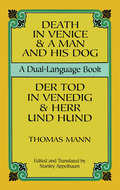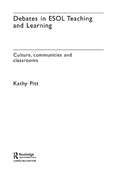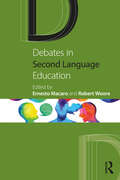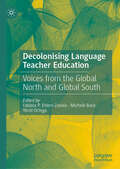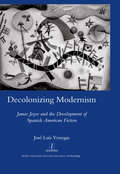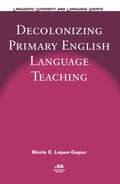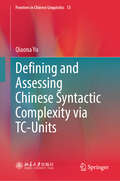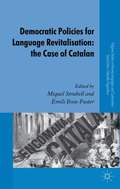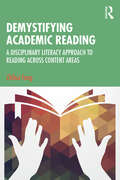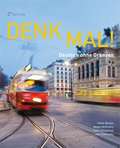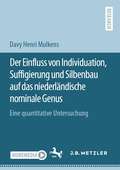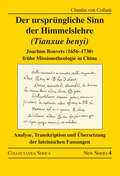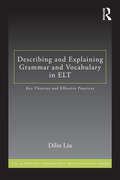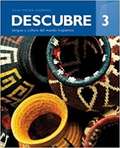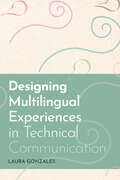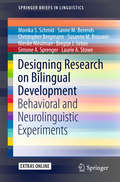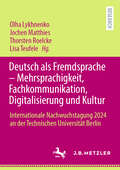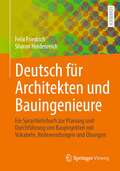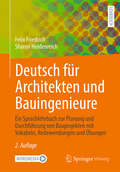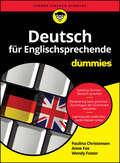- Table View
- List View
Death in Venice & A Man and His Dog: A Dual-Language Book
by Thomas Mann Stanley AppelbaumWritten in 1912, Death in Venice is Thomas Mann's best-known novella -- a haunting, elegiac masterpiece in which the main character, Gustav Aschenbach, is a successful and much-revered author. While vacationing in Venice, this highly disciplined writer, who always has maintained extraordinary control of his literary creations, finds himself suddenly overwhelmed by an all-consuming love for a beautiful young boy. A deadly epidemic sweeps through the city, but Aschenbach's attraction to the youth compels him to remain, thus sealing his fate.The second work in this volume, "A Man and His Dog," concerns Bauschan, a friendly mongrel pointer acquired by the Mann family in 1916. A constant companion during the author's morning walks, the loyal creature also deposited himself regularly under Mann's desk while the author worked -- a gesture not always appreciated by the writer. More of a genial essay or memoir than a "story," this charming piece, including "one of the most beautiful descriptions of landscape in German literature," is reprinted here with its original preface, which is translated (most likely for the first time) into English.For both works, Stanley Appelbaum has provided an introduction and informative notes, along with excellent new English translations on the pages facing the original German.
Debates in ESOL Teaching and Learning: Cultures, Communities and Classrooms (New Approaches to Adult Language, Literacy and Numeracy)
by Kathy PittThis unique book provides a lively introduction to the theory and research surrounding the adult learning of English for Speakers of Other Languages. Offering a digest and discussion of current debates, the book examines a wide geographical and social spread of issues, such as: * how to understand the universal characteristics of learning an additional language* what makes a 'good' language learner* multilingualism and assumptions about monolingualism* learning the written language* the effect of recent Government immigration policy on language learning processes. As a majority of adults learning ESOL are from communities of immigrants, refugees and asylum seekers, understanding the diversity of social and personal history of learners is a critical dimension of this book. It also recognises the social pressures and tensions on the learners away from the classroom and discusses various types of classroom and language teaching methodologies. Full of practical activities and case studies, this book is essential reading for any basic skills teacher undertaking a course of professional development, from GNVQ through to post-graduate level.
Debates in Second Language Education (Debates in Subject Teaching)
by Ernesto Macaro Robert WooreDebates in Second Language Education provides an up-to-date account of the key debates and areas of controversy in the field of second language learning and teaching. Adopting a broad and comparative perspective and emphasising the importance of considering a variety of learning contexts, it encourages students and practising teachers to engage with contemporary issues and developments in learning and teaching. Chapters are designed to stimulate thinking and understanding in relation to theory and practice, and help language educators to make informed judgements by arguing from a position based on theoretical knowledge and understanding. Bringing together leading contributors in the field, the book discusses a wide range of issues relating to second language learning and teaching including: the relationship between age and success in language learning aptitude versus motivation as predictors of successful language learning linguistic diversity and plurilingualism the teaching of grammar and vocabulary the value of phonics learning pronunciation the second language only versus the multilingual debate With reflective points in every chapter, Debates in Second Language Education will be a valuable resource for any student or practising teacher, as well as for those engaged in initial teacher education, continuing professional development or Master's level study. It will also be of interest to second language acquisition researchers and those studying applied linguistics.
Decolonising Language Teacher Education: Voices from the Global North and Global South
by Michele Back Fabiola P. Ehlers-Zavala Yecid OrtegaThis edited book examines decolonization in applied linguistics, focusing on language teacher preparation across the Global North and South. It brings together diverse voices to challenge colonial legacies and promote more just, inclusive, and locally grounded approaches to education. Organized into three sections—challenges, programs, and strategies—the volume first explores systemic barriers that continue to shape language education. It then highlights successful models from varied global contexts, including Southeast Asia, Europe, and the Americas, that reimagine language teacher preparation through critical pedagogy, translanguaging, and community collaboration. The final section offers practical strategies for future action, such as the ethical use of technology to empower marginalized voices in the classroom. With key themes of decolonization, applied linguistics, language teacher education, social justice, and Global North–Global South collaboration, this collection provides essential insights for educators, researchers, and policymakers seeking to reshape language teaching in more equitable and culturally responsive ways.
Decolonizing Modernism: James Joyce and the Development of Spanish American Fiction
by JoseLuis VenegasJames Joyce's Ulysses (1922) has been recognized as a central model for the Spanish American 'New Narrative'. Joyce's linguistic and technical influence became the unequivocal sign that literature in Spanish America had definitively abandoned narrow regionalist concerns and entered a global literary canon. In this bold and wide-ranging study, Jose Luis Venegas rethinks this evolutionary conception of literary history by focusing on the connection between cultural specificity and literary innovation. He argues that the intertextual dialogue between James Joyce and prominent authors such as Argentines Jorge Luis Borges and Julio Cortazar, Cuban Guillermo Cabrera Infante, and Mexican Fernando del Paso, reveals the anti-colonial value of modernist form. Venegas explores the historical similarities between Joyce's Ireland during the 1920s and Spanish America between the 1940s and 70s to challenge depoliticized interpretations of modernist aesthetics and propose unsuspected connections between formal experimentation and the cultural transformations demanded by decolonizing societies. Jose Luis Venegas is Visiting Assistant Professor of Spanish at the University of North Carolina at Greensboro.
Decolonizing Primary English Language Teaching
by Mario E. López-GoparThis book tells the story of a project in Mexico which aimed to decolonize primary English teaching by building on research that suggests Indigenous students are struggling in educational systems and are discriminated against by the mainstream. Led by their instructor, a group of student teachers aspired to challenge the apparent world phenomenon that associates English with "progress" and make English work in favor of Indigenous and othered children's ways of being. The book uses stories as well as multimodality in the form of photos and videos to demonstrate how the English language can be used to open a dialogue with children about language ideologies. The approach helps to support minoritized and Indigenous languages and the development of respect for linguistic human rights worldwide.
Defective Inspectors: Crime-fiction Pastiche In Late Twentieth-century French Literature
by Simon KempCrime fiction is a popular target for literary pastiche in France. From the nouveau roman and the Oulipo group to the current avant-garde, writers have seized on the genre to exploit it for their own ends, toying with its traditional plots and characters, and exploring its preoccupations with perception, reason and truth. In the first full-length study of the phenomenon, Simon Kemp's investigation centres on four major writers of the twentieth century, Alain Robbe-Grillet (b. 1922), Michel Butor (b. 1926), Georges Perec (193682) and Jean Echenoz (b. 1947). Out of their varied encounters with the genre, from deconstruction of the classic detective story to homage to the roman noir, Kemp elucidates the complex relationship between the pasticheur and his target, which demands an entirely new assessment of pastiche as a literary form.
Defining and Assessing Chinese Syntactic Complexity via TC-Units (Frontiers in Chinese Linguistics #13)
by Qiaona YuThis book is a cutting-edge exploration of Chinese syntactic complexity by introducing a Chinese-language-specific approach, and providing a clear rationale and methodology for gauging syntactic complexity development along proficiency increase. It informs research and practice on assessment, proficiency scale and rubric descriptors, and task design for different language performances. This book appeals to a broad audience of researchers, not only those focused on Chinese and other Asian languages but also linguists, applied linguists, and language educators interested in understanding and measuring complexity.
Demian: A Dual-Language Book (Dover Dual Language German)
by Hermann Hesse"All I really wanted was to try and live the life that was spontaneously welling up within me. Why was that so very difficult?"Generations of readers have recognized the impassioned cry that introduces the young narrator of Demian, and embraced this tale of a troubled young man's struggle toward self-awareness. Initially published in Berlin in 1919, the novel met with instant critical acclaim, as well as great popular success among people seeking answers amid the devastating aftermath of World War I.A brilliant psychological portrait of an individual's departure from social conventions in the search for spiritual fulfillment, Demian encompasses many of the themes associated with Hermann Hesse, its Noble Prize–winning author, particularly the duality of human nature and the quest for inner peace.Considered an important work in the evolution of twentieth-century European literature, this perceptive coming-of-age novel enjoys a particular resonance with young adults, a fact that has made Demian a perennial favorite in schools and colleges all over the world. This inexpensive edition, featuring an excellent new English translation, is sure to be welcomed by teachers and students, and by the legions of confirmed Hesse fans.
Democratic Policies for Language Revitalisation: the Case of Catalan
by Emili Boix-Fuster Miquel StrubellA collection of studies offering an up-to-date analysis of official policies to promote Catalan in a democratic framework in each of the main Spanish regions where it is spoken: Catalonia, Valencia and the Balearic Islands.
Demonstratives and Grammaticalization: A Perspective from Modern Turkish
by Metin BalpınarDemonstratives and Grammaticalization offers an in-depth analysis of the demonstrative system in Turkish. This book provides the first comprehensive analysis dealing with both the synchronic variations in Turkish demonstratives and their grammatical changes. It sheds light on the syntactic, semantic, and pragmatic properties of the demonstratives, systematically describes the various usages of these forms, and provides a unified explanation for the various accounts of their distribution. While the focus is on Turkish, this analysis contributes to our understanding of how a demonstrative system operates in a language with a three-way distinction.
Demystifying Academic Reading: A Disciplinary Literacy Approach to Reading Across Content Areas
by Zhihui FangFoundational and accessible, this book equips pre-service and practicing teachers with the knowledge, understanding, tools, and resources they need to help students in grades 4–12 develop reading proficiencies in four core academic subjects—literature, history, science, and mathematics. Applying a disciplinary literacy approach, Fang describes the verbal and visual resources, expert strategies, inquiry skills, and habits of mind that students must learn in order to read carefully, critically, purposefully, and with an informed skepticism across genres and content areas. He also shows how teachers can promote language learning and reading/literacy development at the same time that they engage students in content area learning. With informative synthesis and research-based recommendations in every chapter, this text prepares teachers to help students develop discipline-specific, as well as discipline-relevant, discursive insights, literacy strategies, and ways of thinking, reasoning, and inquiring that are essential to productive learning across academic subjects. It also provides teacher educators with approaches and strategies for helping teacher candidates develop expertise in academic reading instruction. In so doing, the book demystifies academic reading, revealing what it takes for students to read increasingly complex academic texts with confidence and understanding and for teachers to develop expertise that promotes disciplinary literacy. This state-of-the-art text is ideal for courses on reading/literacy methods and academic literacy and eminently relevant to all educators who want their students to become thoughtful readers and powerful learners
Denk Mal! Deutsch ohne Grenzen: Deitsch Ohne Grezen
by Tobias Barske Megan McKinstry Karin SchestokatNIMAC-sourced textbook
Der Einfluss von Individuation, Suffigierung und Silbenbau auf das niederländische nominale Genus: Eine quantitative Untersuchung
by Davy Henri MulkensWie in vielen anderen Sprachen auch verläuft die Genuszuweisung bei niederländischen Substantiven – im Gegensatz zu dem, was andere Forscher oft behaupten – nicht arbiträr, sondern wird von verschiedenen Faktoren beeinflusst. Für die vorliegende Studie wurde aus mehreren Faktoren jeweils ein semantischer, ein morphologischer und ein phonologischer Faktor zur Analyse ausgewählt und empirisch gewonnene Daten mittels logistischer Regressionsanalyse ausgewertet. Der Einfluss von Individuation, Suffigierung und Silbenbau auf das nominale Genus konnte hierdurch eindeutig nachgewiesen und die Arbiträritätsthese verworfen werden. Somit stellt diese Arbeit nicht nur einen wichtigen Meilenstein in der niederländischen Genusforschung dar, sondern lädt auch zu weiteren Studien im nominalen Genusbereich ein
Der ursprüngliche Sinn der Himmelslehre: Joachim Bouvets (1656–1730) frühe Missionstheologie in China. Analyse, Transkription und Übersetzung der lateinischen Fassungen (Collectanea Serica. New Series #4)
by Claudia von CollaniThe author focuses on one of the most fascinating texts of the 17th and 18th century China mission – the Tianxue benyi 天學本義 (The Original Meaning of the Heavenly Teachings) and the more elaborate Gujin jingtian jian 古今敬天鑒 (Mirror on the Worship of Heaven in Ancient Times and Nowadays), both written and compiled by the Jesuit Joachim Bouvet (1656–1730) with the assistance of Chinese converts. The two works were even translated into Latin in order to support the Jesuit position in the Chinese Rites Controversy in the Roman Curia. Through them, Bouvet presented the Jesuit missionary strategy of accommodation in a nutshell: He aimed at introducing Christianity in the terms of Chinese traditional culture. Thus, Bouvet’s approach can be characterised as an early attempt at a contextualized theology which is meaningful even for contemporary discussions. The present study offers an introduction to Bouvet’s thoughts and works and their respective historical and theological context, a transcription of the Latin texts – the Cœlestis Disciplinæ vera notitia and the De cultu cœlesti Sinarum veterum & modernorum – with an annotated German translation.
Describing and Explaining Grammar and Vocabulary in ELT: Key Theories and Effective Practices (ESL & Applied Linguistics Professional Series)
by Dilin LiuLanguage description plays an important role in language learning/teaching because it often determines what specific language forms, features, and usages are taught and how. A good understanding of language description is vital for language teachers and material writers and should constitute an important part of their knowledge. This book provides a balanced treatment of both theory and practice. It focuses on some of the most important and challenging grammar and vocabulary usage questions. Using these questions as examples, it shows how theory can inform practice and how grammar and vocabulary description and explanation can be made more effective and engaging. Part I describes and evaluates the key linguistic theories on language description and teaching. Part II discusses and gives specific examples of how challenging grammar and vocabulary issues can be more effectively described and explained; each chapter focuses on one or more specific grammar and vocabulary. An annotated list of useful free online resources (online corpora and websites) for grammar and vocabulary learning and teaching, and a glossary provide helpful information.
Designing Multilingual Experiences in Technical Communication
by Laura GonzalesAs technical communicators continue advocating for justice, the field should pay closer attention to how language diversity shapes all research and praxis in contemporary global contexts. Designing Multilingual Experiences in Technical Communication provides frameworks, strategies, and best practices for researchers engaging in projects with multilingual communities. Through grounded case studies of multilingual technical communication projects in the US, Mexico, and Nepal, Laura Gonzales illustrates the multiple tensions at play in transnational research and demonstrates how technical communicators can leverage contemporary translation practices and methodologies to engage in research with multilingual communities that is justice-driven, participatory, and reciprocal. Designing Multilingual Experiences in Technical Communication is of value to researchers and students across fields who are interested in designing projects alongside multilingual communities from historically marginalized backgrounds.
Designing Research on Bilingual Development
by Monika S. Schmid Sanne M. Berends Christopher Bergmann Susanne M. Brouwer Nienke Meulman Bregtje J. Seton Simone A. Sprenger Laurie A. StoweThis volume offers an in-depth description and discussion of research design for a large-scale investigation of bilingual development. It introduces and justifies a range of theoretical and methodological innovations, discusses some of the problems that come with these and proposes practical solutions. The present volume introduces a research design intended to capture a wide range of linguistic data, elicited by means of behavioral tasks, neuroimageing data and free speech from both second language learners and first language attriters of two languages (Dutch and German) representing a wide range of language combinations and ages of onset. Gathering and analyzing such a range of data comes with a multiplicity of problems, many of them linked to the fact that similar tests have to be designed across a range of languages and measurements will have to occur in various locations. The current volume presents a research design appropriate to these questions, discussing the methodological challenges of such a study. It offers advice on how to construct experimental materials which are parallel across different languages set up a protocol for additional measures which can be applied across a wide range of participants combine data from different labs when using different ERP equipment and different eyetrackers.
Desire in Dante and the Middle Ages
by Manuele GragnolatiThis volume takes Dante's rich and multifaceted discourse of desire, from the Vita Nova to the Commedia, as a point of departure in investigating medieval concepts of desire in all their multiplicity, fragmentation and interrelation. As well as offering several original contributions on this fundamental aspect of Dante's work, it seeks to situate the Florentine more effectively within the broader spectrum of medieval culture and to establish greater intellectual exchange between Dante scholars and those from other disciplines. The volume is also notable for its openness to diverse critical and methodological approaches. In considering the extent to which modern theoretical paradigms can be used to shed light upon the Middle Ages, it will interest those engaged with questions of critical theory as well as medieval culture.
Deutsch als Fremdsprache – Mehrsprachigkeit, Fachkommunikation, Digitalisierung und Kultur: Internationale Nachwuchstagung 2024 an der Technischen Universität Berlin
by Olha Lykhnenko Jochen Matthies Thorsten Roelcke Lisa TeufeleDie internationale Nachwuchstagung Deutsch als Fremdsprache, die im Januar 2024 an der Technischen Universität Berlin stattfand, bot jungen Forschenden eine Plattform zur Präsentation ihrer Arbeiten sowie zur Vernetzung. In dem vorliegenden Band werden Beiträge aus den Themenbereichen Mehrsprachigkeit, Fachkommunikation und Wissenschaftliches Schreiben, Professionalisierung und Digitale Medien sowie Kultur und Literatur veröffentlicht. Sie spiegeln das vielfältige Interesse der Teilnehmenden und die große Bandbreite ihrer Forschung im Bereich Deutsch als Fremdsprache wider.
Deutsch für Architekten und Bauingenieure: Ein Sprachlehrbuch zur Planung und Durchführung von Bauprojekten mit Vokabeln, Redewendungen und Übungen
by Sharon Heidenreich Felix FriedrichEin Sprachlehrbuch, das speziell für Architekten, Bauingenieure und verwandte Berufsgruppen aller Nationalitäten konzipiert ist, die ihre deutsche Kommunikationsfähigkeit im beruflichen Kontext verbessern wollen. Das Buch kann sowohl für das Selbststudium als auch kursbegleitend eingesetzt werden. Nachdem in der 1. Hälfte des Buches viele Grundlagen der Bauwirtschaft behandelt werden, orientiert sich die 2. Hälfte an den Leistungsphasen und der Abwicklung von Beispielprojekten. Pro Kapitel werden Fachvokabular, Redewendungen, Kommunikationsformen und auch Grammatik vermittelt. Übungen und Aufgaben mit Lösungen runden das Werk ab.Nach dem Gemeinsamen europäischen Referenzrahmen (GER) für Sprachen entspricht das Lehrwerk einem Niveau von B2/C1.
Deutsch für Architekten und Bauingenieure: Ein Sprachlehrbuch zur Planung und Durchführung von Bauprojekten mit Vokabeln, Redewendungen und Übungen
by Sharon Heidenreich Felix FriedrichEin Sprachlehrbuch, das speziell für Architekten, Bauingenieure und verwandte Berufsgruppen aller Nationalitäten konzipiert ist, die ihre deutsche Kommunikationsfähigkeit im beruflichen Kontext verbessern wollen. Das Buch kann sowohl für das Selbststudium als auch kursbegleitend eingesetzt werden. Nachdem in der 1. Hälfte des Buches viele Grundlagen der Bauwirtschaft behandelt werden, orientiert sich die 2. Hälfte an den Leistungsphasen und der Abwicklung von Beispielprojekten. Pro Kapitel werden Fachvokabular, Redewendungen, Kommunikationsformen und auch Grammatik vermittelt. Übungen und Aufgaben mit Lösungen runden das Werk ab. Neu in der 2. Auflage: Alle Dialoge stehen als Audiodateien zur Verfügung. Durch QR-Codes im Buch können diese abgerufen und direkt angehört werden. Nach dem Gemeinsamen europäischen Referenzrahmen (GER) für Sprachen entspricht das Lehrwerk einem Niveau von B2/C1.
Deutsch für Englischsprechende für Dummies
by Paulina Christensen Anne Fox Wendy FosterWenn es mehr als »Guten Tag« sein soll »Deutsch für Englischsprechende« bietet einen leichten Einstieg in die deutsche Sprache. Das Buch ist in Englisch geschrieben. Hier lernen Sie alles Wissenswerte zur deutschen Grammatik und zur Konjugation der Verben. Und die Downloaddateien mit Dialogbeispielen aus dem richtigen Leben helfen Ihnen, die Aussprache zu erlernen. »German for Dummies« offers an easy introduction to the German language for English speakers. You will learn the essentials you need to know about grammar and verb conjugation. And the download files with real-life dialog examples will help you learn the pronunciation. Sie erfahren Wie Sie im Deutschen richtig betonen - How to emphasize German words correctly Wie Sie sich auf Deutsch zurechtfinden - How to find your way around in German Wie Sie deutsche Redewendungen richtig benutzen - How to use German idioms correctly
